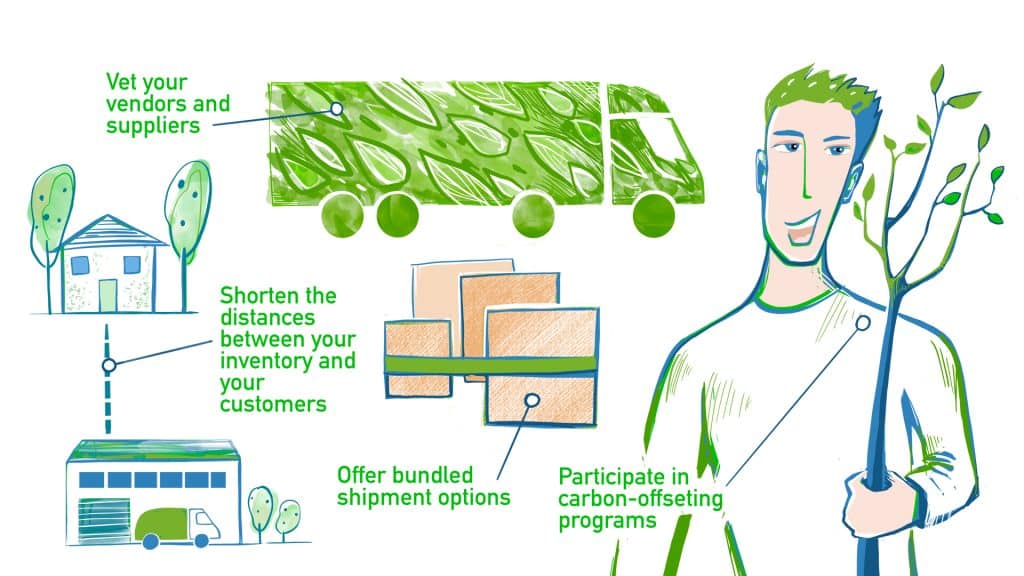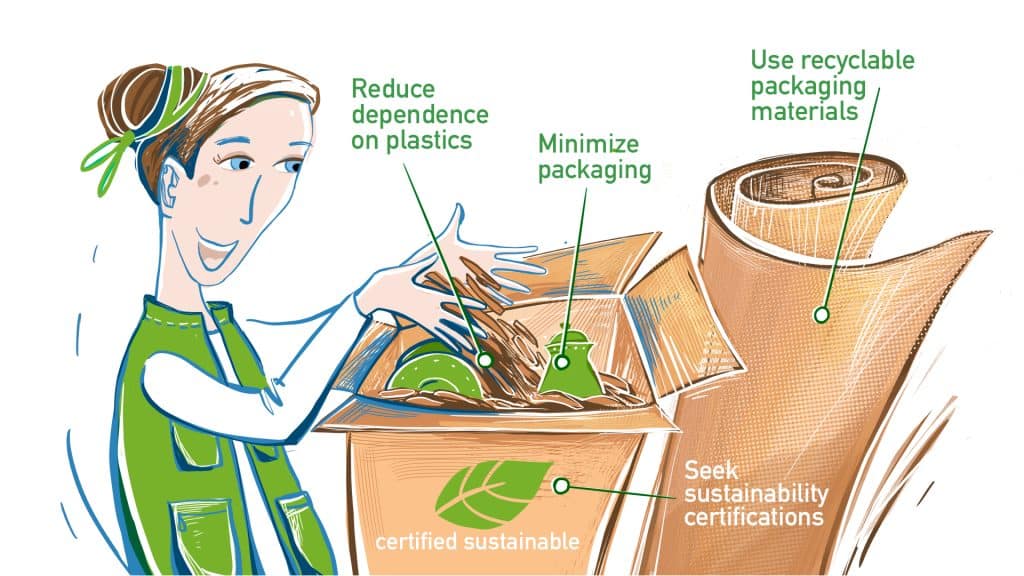
As customers increasingly turn to ecommerce for their purchases, they are starting to voice concerns over the environmental impacts of online shopping. Sure, it’s convenient, but what about the pollution and energy use associated with having everything delivered to your doorstep? What about all that packing material that ensures merchandise arrives safely?
It should be no surprise that studies have shown that customers are more likely to show loyalty to brands and businesses that have committed to sustainable and eco-friendly practices for years now. Many are even willing to pay a little more or wait a bit longer for their orders if they believe it is for an environmentally conscious reason.
This trend in consumer sentiment makes environmentally conscious ecommerce not only the right thing to do but also a potentially lucrative marketing opportunity for brand growth. Moreover, some sustainable and eco-friendly business practices can help boost your brand’s overall productivity and efficiency.
Reducing carbon emissions and using eco-friendly materials are the two most significant ways your online retail business can make a meaningful environmental impact.
Know and Respond to Your Ecommerce Business’s Carbon Footprint
According to a US Environmental Protection Agency (EPA) study, transportation accounted for 29% of total greenhouse gas (GHG) emissions in 2019. If current trends persist, ecommerce will play an increasing role in solving that problem as the industry grows. A World Economic Forum study projects that last-mile delivery could increase GHG emissions by over 30% in the next ten years.
While technological advancements in hybrid and zero-emissions freight methods could reduce or eliminate this concern, this type of change takes time and financing—it won’t happen overnight. That same EPA report found that electricity accounted for 25% of 2019’s GHG emissions, and industry accounted for 23%. Considering how heavily these three areas are intertwined with ecommerce, retail, and logistics, your brand’s choices can potentially have a positive impact.
So, what can you do to help reduce your ecommerce business’s carbon footprint and demonstrate to your customers that you take your brand’s environmental impact seriously?
Vet Your Vendors and Suppliers
While you don’t directly control the energy and transportation decisions made by your third-party vendors and suppliers, it can be a consideration when deciding whom you do business with. Many shipping companies and manufacturers are becoming increasingly forthright about their environmentally focused policies. (This is good marketing for them, too!)
If you take your brand’s environmental impact seriously, make environmental impact one of the factors you use to evaluate your third-party partners.
Offer Bundled Shipment Options
In the case of Amazon, Prime subscribers tend to make multiple purchases in a single shopping session, either for individual or smaller orders. This can result in multiple unique orders that arrive at the customer’s door via the same truck on the same day but are packaged separately.
For your ecommerce business, rather than shipping multiple-item shipments piecemeal, be proactive about offering customers the option to have all their merchandise shipped in the same package and/or shipment.
This reduces freight and last-mile emissions. That said, if the products for an order are spread across multiple warehouses, this may not be as viable (or carbon-efficient).
Shorten the Distances Between Your Inventory and Your Customers
Speaking of multiple warehouses, there is a benefit to both your carbon footprint and shipping speeds if you can position your inventory close to where your customers are located. Descartes Sellercloud makes it easy to track and manage inventory across multiple locations, allowing you to expand your reach to better serve new regions of customers.
Taking things even further, if you have inventory stored in multiple locations, Descartes Sellercloud’s Order Rule Engine can automatically choose to fulfill orders based on the warehouse closest to the customer’s destination.
The result is faster and more eco-friendly fulfillment.
Participate in Carbon-Offsetting and Carbon-Bundling Programs
For now, it is nearly impossible to operate a zero-emission ecommerce business. The technology and infrastructure are still developing and evolving. However, nonprofit organizations like the International Carbon Reduction and Offset Alliance (ICROA) offer businesses an opportunity to invest in emission-reducing and eliminating activities at a rate proportional to their own GHG emissions.
These voluntary carbon marketplaces are critical forces in achieving more permanent and lasting climate-change solutions for our planet. Taking responsibility for your ecommerce business’s carbon output is an important step toward becoming a green brand, but it isn’t the only one.
Adjustments to how you package your products and the products themselves can improve your environmental impact.

The Materials You Choose Can Have a Meaningful Environmental Impact
Just as there are many ways that your business can minimize its carbon footprint, there are various ways to make green decisions about the materials you use to both make and ship your products:
Minimize Packaging
One of the areas most ripe for greenifying your ecommerce practices is likely your packaging. Because of the need for shipping, ecommerce tends to produce more waste than traditional brick-and-mortar retail.
Shipping materials are one of the chief culprits, but there are ways to reduce or eliminate their impact. When shipping boxed products, consider applying shipping labels directly to the packaging without putting them into additional cartons (this is becoming increasingly popular with Amazon and other big-name retailers).
Similarly, when shipment packaging is necessary, strive to use cartons, mailers, and shipping materials that are as optimized as possible for your product sizes. This reduces the amount of void fill material per package and the overall amount of waste material customers have to deal with.
Minimizing and optimizing your shipping dimensions can also result in major fulfillment cost savings. And don’t forget about the products themselves. Try to keep the amount of material—particularly plastics—to a minimum.
Smaller, more eco-friendly product packaging can also reduce the size of the shipment packaging needed to safely deliver your merchandise to customers’ doorsteps.
Use Recyclable Packaging Materials
When packaging is necessary, opt for materials that can be easily recycled. Even better, using materials that have already been recycled demonstrates an even deeper commitment to sustainable packaging.
Reduce Dependence on Plastics
Petroleum-based plastics are some of the most devastating sources of solid waste pollution. Replacing plastic components and/or packaging materials with greener options should be an important priority for environmentally-conscious brands.
If plastics are essential to your merchandise, packaging, or shipping supplies, seeking recyclable and non-petroleum-based plastics can make a difference.
Seek Sustainability Certifications
Adhering to the Cradle to Cradle (C2C) certification standard is one way to improve the sustainability of your products and packaging. The Cradle to Cradle Products Innovation Institute is an internationally recognized institution dedicated to promoting materials and products that have positive planetary and societal benefits.
To do so, the C2C certification process evaluates products across five areas: material health, material reutilization, renewable energy and carbon management, water stewardship, and social fairness. A C2C certification is a visible and marketable way to show consumers that your company takes its environmental impact seriously.
There are more options than ever for supporting Earth-friendly business decisions. Taking advantage of them can be both good-intentioned and good business. As with any shifts and evolutions of your ecommerce business practices, Descartes Sellercloud’s omnichannel ecommerce growth platform empowers you with the tools to optimize and streamline your inventory-based workflows.
Our over 350 integrations with leading marketplaces, shippers, suppliers, logistics partners, and more allow you to manage your partnerships from a single, convenient interface.
Contact us directly for a free demo and start transforming how your brand does ecommerce.




